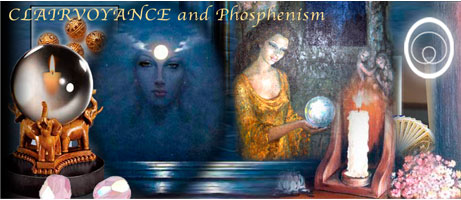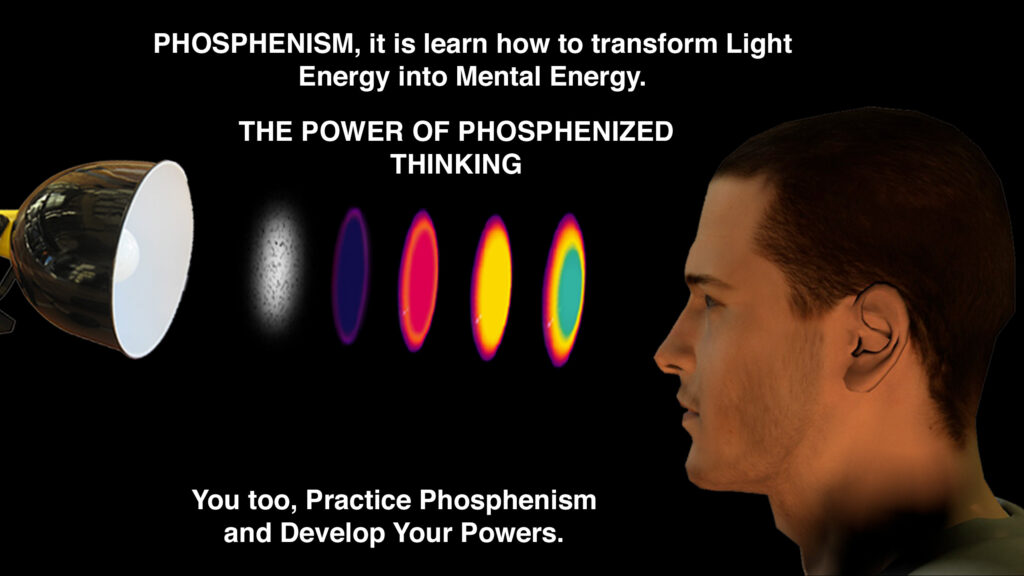CLAIRVOYANCE

CLAIRVOYANCE
Clairvoyance is the ability to perceive information through visual subjective perceptions. Clairvoyance takes place in a flash, through the appearance of very brief mental images which interpretation is obvious rather symbolic.
Clairvoyance is different from divinatory sciences. The latter consist in an intellectual interpretation of signs obtained through various media (cards, star charts, etc.)
Since the beginning of humankind, people have aimed to foresee the future, to determine the most auspicious moment for undertaking an action, etc. Clairvoyance has been practiced in all the domains of human activity.
Sometimes, clairvoyance became an institution. It was the case with many civilizations of the ancient world, for example in Delphi, where the people used to consult the Oracle and its priestesses, the Pythia, who obtained visions by focusing on a fire.
Clairvoyants generally use a medium to produce visions: a crystal ball, fire, a bowl full of water, torches, etc. The common characteristic of these media is that they all are related to light. Again, clairvoyance differs from the divinatory sciences because of the nature of the media used.
Dr Francis Lefebure, a French physician and researcher, made many discoveries in cerebral physiology. These discoveries explain the mecanisms of clairvoyance. His research was based on the systematic use of the phosphenes. The phosphenes are all the subjective sensations of light, i.e. those which are not directly provoked by light stimulating the retina. Phosphenes can be obtained by focusing on sources of light for short periods of time.
Dr Lefebure defined a certain number of parameters that come into play in phenomena of clairvoyance. The production of phosphenes using sources of light is systematic. For this purpose, clairvoyants use varied supports. Placing a candle near a crystal ball, for example, creates lighting conditions suitable for clairvoyance. The use of a fire, the moon or of the reflection of the sun on water produce the same kind of effects.
Polarized light, i.e. light reflected by a surface, is particularily conductive, as Dr Lefebure demonstrated. The light of the moon, the reflection of the sun on water or the reflection of a candle on a crystal ball belong to this category.
In Phosphenism: The Scientific Explanation of the Origins of Religion, Dr Lefebure analyses the circumstances in which certain clairvoyants developed their gift.
Pentier, the fisherman from Berck
‟It was a man called ‛le père Pentier’ by the population of Berck (Pas-de-Calais, France). His gift of clairvoyance was quite famous in the area, and we were able to verify that his reputation was deserved. He talked very little, but everything he foresaw happened. He was retired, but he used to be a fisherman.
According to a custom of the time, he always used to pray while he was working and he attributed his gift of clairvoyance to the fact that he prayed to Saint-Côme and Saint-Damien. He believed that these saints were particularly powerful because they came from primitive Christianity. But, as with other cases that we had the chance to study, and though he actually was a clairvoyant, we believe that he was mistaken on the cause of his gift, though this assumption might seem surprising. Indeed, the two syllables ‛Côm’ and ‛Dam’ hammered out his litanies: we believe that it is thanks to them that he practiced rhythmic thinking. Also, he told us that in the beginning, his clairvoyance only took place when he focused on water.
It is only much later that we understood why: he mixed his litanies to the two saints with the phosphenes produced by the reflection of the sun on water, and it is only after a long maturation of his brain by this exercise that his clairvoyance could persist in the absence of phosphenes.
Let us also quote the case of Mrs. Spique, who since the age of six has been subject to real bouts of clairvoyance; for example, while she was talking about something completely different, she used to see a white ball that started whirling. Inside this ball, as it became transparent, appeared visions that she described. On one occurence, she gave us many details about a character that coincided exactly with our father, who had been deceased for a long time and about whom we had never talked to her. The precision of the details was amazing, as she described the major part of our relationship with our father.
When she was a child, she used to scare the people around her by announcing deaths or accidents that took place soon afterwards.
She told us that when she used to live in Algiers (Algeria) between the age of three and six, she had such a degree of rachitis of the lower limbs that she was disabled, and could absolutely not walk. During this period, in order to fortify her, she was taken to the beach with a doll and, as she would get bored quickly by this toy, she used to spend hours looking at the reflection of the sun on water as a game.
It is interesting to note that this habit not only seems to have developed her clairvoyance, but also seems to have had a favorable action on her character as she developed a great generosity.”
The poetess Minou Drouet
‟Everyone in France knows the child prodigy Minou Drouet whose poems amazed the world, when she was only 12 years old. She was so famous for a while that, sometimes when she visited provincial towns, crowds would gather as if she was a head of state.
All her biographies agree to say that while she was in an orphanage, she seemed slightly retarded. Her foster mother took her to a house that was located near the ocean and, instead of sending her to school, let her do as she pleased. We have learned, from her mother, that she used to look at the reflection of the sun on water for hours, every day, and that at the same time, she swayed softly her head from left to right. After a few years of this solitary game, the people around her realized that she had become a genius.
The process that took place here seems obvious to us and will be confirmed by another case that we will quote later. When she focused on the reflection of the sun on water, she mixed her child reveries with the phosphenes produced by the movements of this reflection.
Moreover, as we have seen previously, swaying on a pendular rhythm of two seconds is a natural rhythm of the phosphenes. Thanks to this watery mirror, Phosphenism carried her along into this rhythm, as the pendular motion of the phosphenes and the movements of the waves are of a similar nature: sinusoidal.
Experimenting with hearing a sound alternatively in and the right and the left ear, thanks to a device called ‛Alternophone’, has showed that these alternating stimulations are very beneficial for the functioning of the brain. They develop a stronger attention, sharpen artistic sensitivity, but also make thoughts surge in a polarized form, a process that favors the creation of verses. As does Phosphenic Mixing, this alternating hearing process simultaneously increases the quality and the quantity of ideas.
The action of Mixing and the action of alternating hearing thus belong to the same category of phenomena, and have led us to the discovery a previously unknown function of the brain that we have called ‛rhythmo-phosphenic’ function.”
Minou was guided by her instincts towards the phosphenes produced by the reflection of the sun on the moving waves. The latent rhythmic power of the phosphenes manifests itself as soon as it has a chance: Minou instinctively started swaying her head, another practice which has the ability to develop a more vivid intelligence by its effects on the higher abilities of the brain.
Exercise: contemplating the reflection of the sun on water
Find a suitable stretch of water. A simple basin will suffice.
Place yourself in a way that allows you contemplate the reflection of the sun on the water.
Wear a cap, so that the sun does not shine directly on your eyes.
Focus on the reflection. You will see various forms appear: arrows, triangles, crosses, snakes of fire… These perceptions are your cerebral rhythms that are activated by light and the rhythm of the ripples.
After approximately three minutes, close your eyes and observe the colors.
With a little bit of practice, you might perceive visions of characters or sceneries in the reflection of the sun.
Importante Note
We have done our best to provide you with the most accurate translation of our french website. Nevertheless, it is possible that some language errors may remain. So, don’t hesitate to contact us to communicate them to us.
Thank you for your indulgence and for your consideration of the many hours spent translating all our pages and, more particularly, all the testimonies we share with you so that you may become aware of the impact that Phosphenism can have on those who practice it.
Wishing you the best with your practice of Phosphenism.
Daniel Stiennon (Dr. LEFEBURE School Director, France)


